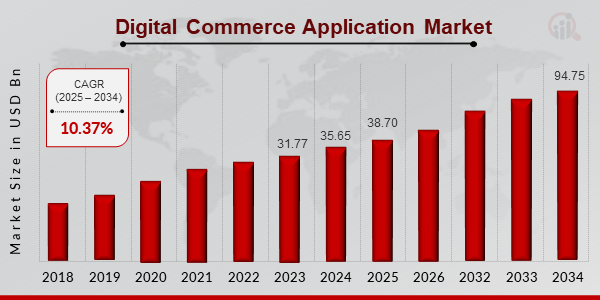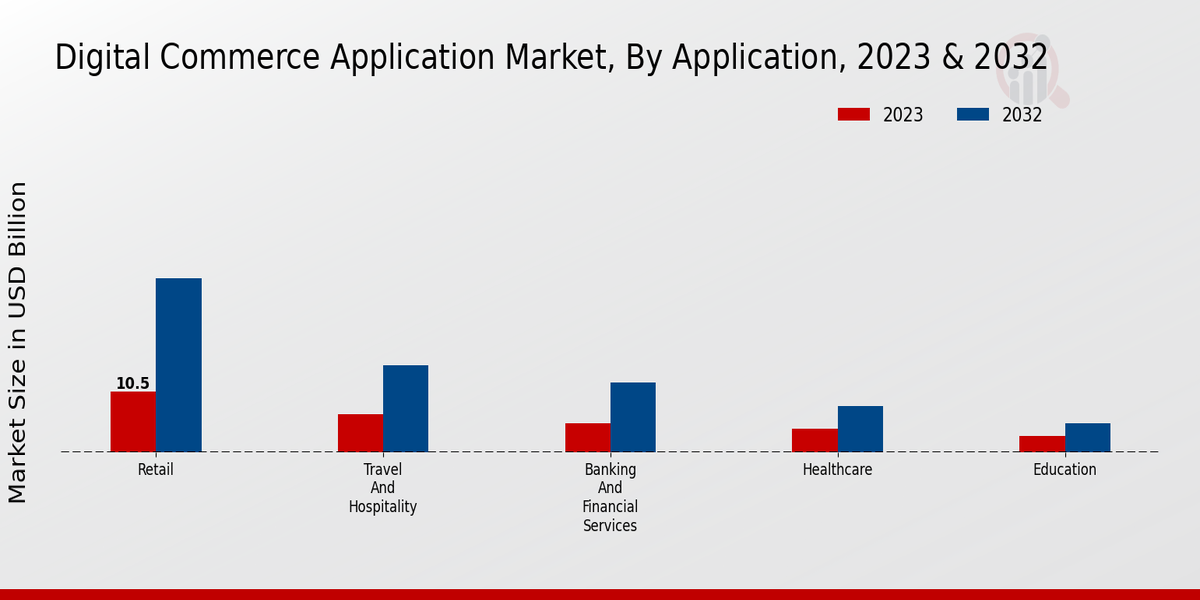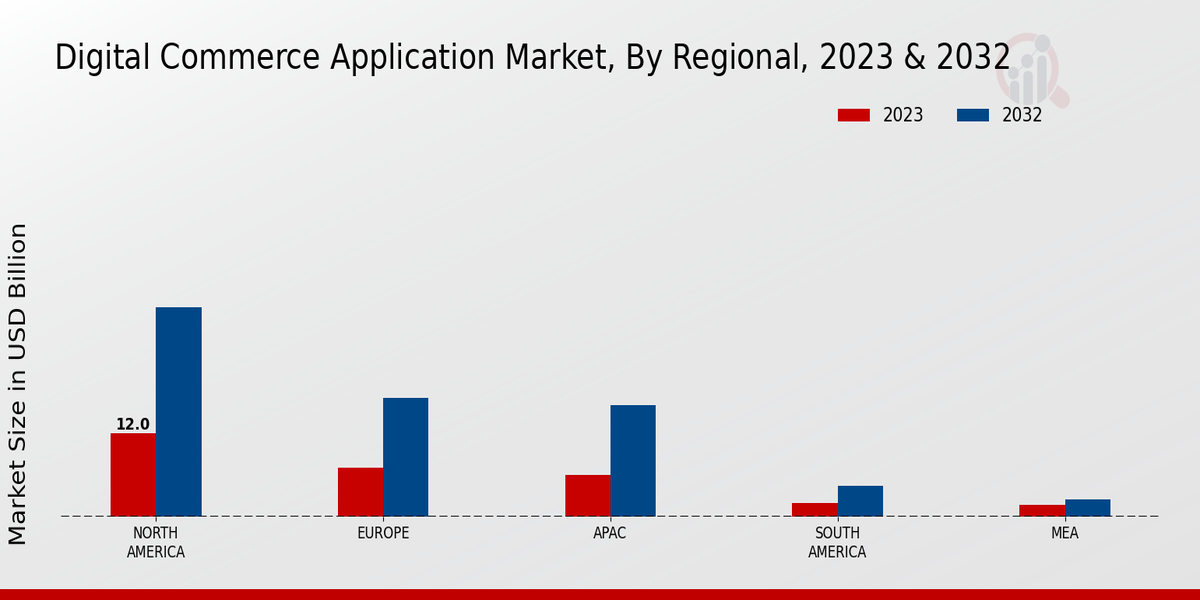Digital Commerce Application Market Overview
Digital Commerce Application Market is projected to grow from USD 38.70 Billion in 2025 to USD 94.75 Billion by 2034, exhibiting a compound annual growth rate (CAGR) of 10.37% during the forecast period (2025 - 2034). Additionally, the market size for Digital Commerce Application Market was valued at USD 35.65 billion in 2024.
Key Digital Commerce Application Market Trends Highlighted
The Digital Commerce Application Market is witnessing significant growth driven by the increase in smartphone penetration, the rise of e-commerce, and the growing preference for online shopping. The demand for seamless and personalized shopping experiences has made it essential for businesses to adopt effective digital commerce solutions. As consumers increasingly seek convenience and flexibility, the emphasis on mobile-friendly platforms and user-centric designs has grown. The integration of advanced technologies, like AI and machine learning, facilitates better customer engagement and tailored marketing strategies, further fueling market expansion.
There are substantial opportunities to be explored within this market. Businesses can harness the power of data analytics to understand consumer behavior and preferences, enabling them to create more targeted marketing campaigns. Additionally, the rise of social commerce and influencer marketing presents new avenues for brands to connect with their audience. By integrating digital commerce with social media platforms, brands can enhance their reach and create engaging shopping experiences that resonate with modern consumers. Companies that adopt innovative strategies, including subscription services and loyalty programs, stand to benefit from increased customer retention and satisfaction.
Recent trends in the digital commerce landscape include an acceleration towards omnichannel strategies, where consumers interact with brands through various channels before making a purchase. There is also a growing emphasis on sustainability, prompting businesses to implement eco-friendly practices in their operations. The shift towards contactless payments has gained traction, reflecting a broader trend in consumer behavior aimed at enhancing convenience and safety. As technology continues to evolve, the digital commerce market will continue to adapt, offering new solutions that cater to changing consumer demands. Businesses that stay ahead of these trends will find themselves well-positioned for future success.
Figure 1: Digital Commerce Application Market Size, 2025-2034 (USD Billion)

Source: Primary Research, Secondary Research, MRFR Database and Analyst Review
Digital Commerce Application Market Drivers
Rapid Growth of E-Commerce
The Digital Commerce Application Market Industry is experiencing rapid growth, largely fueled by the increasing adoption of e-commerce platforms worldwide. As more consumers turn to online shopping due to its convenience, the demand for digital commerce applications is surging. The rise of smartphones and internet accessibility has also contributed to this trend, enabling consumers from various demographics to shop online. This transition from physical retail to digital commerce is reshaping consumer behavior and purchasing patterns, creating a significant opportunity for businesses to invest in digital commerce solutions.
Moreover, the COVID-19 pandemic accelerated this shift as people sought safe and efficient ways to purchase goods and services without leaving their homes. As a result, retailers are increasingly focusing on enhancing their online presence and investing in applications that facilitate seamless transactions, customer management and digital marketing. With the expected market value reaching substantial figures in the coming years, the digital commerce landscape is set to expand further, encouraging innovation and competitive strategies among service providers in the Digital Commerce Application Market.
Integration of Advanced Technologies
The integration of advanced technologies such as artificial intelligence (AI), machine learning (ML), and big data analytics is playing a pivotal role in driving the Digital Commerce Application Market Industry forward. These technologies enable businesses to personalize customer experiences, streamline operations, and optimize supply chain management. For instance, AI-driven recommendation systems can analyze buying patterns and provide tailored suggestions, thereby increasing customer satisfaction and loyalty.
Furthermore, businesses are utilizing data analytics to gain insights into market trends, consumer preferences, and inventory management, which in turn enhances decision-making processes. As technological advancements continue to evolve, the potential for enhanced performance and efficiency in digital commerce applications will attract more businesses to invest in this sector, promoting growth and profitability.
Growing Mobile Payment Solutions
The increasing popularity of mobile payment solutions is significantly contributing to the growth of the Digital Commerce Application Market Industry. As mobile wallets and payment apps gain traction among consumers, the ease of making transactions through smartphones has changed the way people shop online. These solutions offer a faster and more secure payment method, which aligns with consumers' expectations for convenience and efficiency in their shopping experiences.
Mobile payment platforms are continuously developing to support a variety of payment options, including contactless payments, peer-to-peer transactions, and virtual currencies. As more businesses implement these solutions to cater to changing consumer preferences, the overall digital commerce ecosystem will benefit. This trend is likely to foster increased consumer trust and higher transaction volumes across digital commerce channels, further driving market growth.
Digital Commerce Application Market Segment Insights
Digital Commerce Application Market Application Insights
The Digital Commerce Application Market is poised for substantial growth, reflecting a robust valuation of 28.79 USD Billion in 2023, with projections leading to 70.0 USD Billion by 2032, showcasing the dynamic nature of the industry. The market encompasses various applications and is segmented into critical areas such as Retail, Travel and Hospitality, Banking and Financial Services, Healthcare, and Education. The Retail application dominates the market with a valuation of 10.5 USD Billion in 2023 and is projected to reach 30.0 USD Billion by 2032, highlighting its substantial influence as ease of online shopping continues to drive consumer behavior, showcasing its majority holding in the overall market.
Travel and Hospitality, valued at 6.5 USD Billion in 2023 and expected to grow to 15.0 USD Billion, reflects the resurgence of the travel industry post-pandemic, emphasizing the essential role digital commerce plays in booking and service delivery for travelers. The Banking and Financial Services sector holds a notable position with a value of 5.0 USD Billion in 2023, aiming for 12.0 USD Billion by 2032, as the shift toward digital banking solutions and financial technology offers consumers greater access and convenience in managing their finances.
Healthcare also shows a significant presence, valued at 4.0 USD Billion in 2023 and projected to increase to 8.0 USD Billion, driven by the growing need for telehealth services and digital patient engagement, underlining its crucial contributions during health crises. Education, although the smallest segment with a valuation of 2.79 USD Billion in 2023 and expected to reach 5.0 USD Billion, is vital in transforming learning experiences through digital platforms, shaping the future of education and thus getting recognition in this market landscape.
The Digital Commerce Application Market statistics indicate that each segment not only plays a pivotal role individually but collectively enhances the entire digital commerce ecosystem, supporting a market growth trajectory that aligns with the evolving needs of consumers across various sectors. As these segments continue to expand, opportunities will arise from technological advancements and changing consumer preferences, further shaping the landscape of digital commerce applications globally.

Source: Primary Research, Secondary Research, MRFR Database and Analyst Review
Digital Commerce Application Market Deployment Model Insights
The cloud-based segment has emerged as a major contributor, driven by its flexible infrastructure and scalability, which empowers businesses to enhance their online presence and customer engagement. This model addresses the increasing demand for accessible and cost-effective digital solutions, making it popular among small to medium-sized enterprises.
On the other hand, the On-Premises model continues to be significant for organizations that prioritize data security and compliance, offering them more control over their systems and operations. As the Digital Commerce Application Market evolves, both deployment models showcase unique advantages, catering to diverse business needs while contributing to the overall growth of the market. Notably, factors such as the rise in e-commerce, mobile shopping trends, and advancements in technology further fuel the market growth, reflecting the adaptability and efficiency of deployment strategies in meeting customer demands.
Overall, the segmentation of the Digital Commerce Application Market based on the Deployment Model plays a crucial role in shaping its growth trajectory and responding to industry dynamics.
Digital Commerce Application Market Payment Method Insights
The Digital Commerce Application Market focuses significantly on the Payment Method segment, which has shown substantial growth. Over the years, various methods, including Credit/Debit Cards, Digital Wallets, Bank Transfers, Buy Now Pay Later, and Cryptocurrency, have transformed how consumers conduct transactions. Credit/Debit Cards remain a dominant form of payment due to their convenience and acceptance worldwide, appealing to a large consumer base. Digital Wallets have gained traction, offering seamless transactions and enhanced security, making them increasingly popular among tech-savvy users.
Bank Transfers continue to be a reliable option, particularly for higher-value purchases, while Buy Now Pay Later has emerged as a crucial solution for consumers looking to spread costs without interest. Additionally, Cryptocurrency is carving out its own niche, offering an alternative payment method with the potential for high returns and security through blockchain technology. As the Digital Commerce Application Market segmentation evolves, these payment methods not only address diverse consumer needs but also illustrate significant trends toward digitalization, convenience, and flexibility in financial transactions.
The overall market growth is augmented by the rising acceptance and integration of these payment solutions, reflecting changing consumer behavior and technological advancements.
Digital Commerce Application Market End Use Insights
This growth is driven by the adoption of digital solutions across various sectors, including the rise of e-commerce platforms that cater to diverse user needs. Within the End Use segmentation, Small and Medium Enterprises play a crucial role as they increasingly leverage digital commerce applications to enhance operational efficiency and expand market reach. Large Enterprises, on the other hand, often dominate the market, utilizing advanced digital solutions to streamline their supply chains and improve customer engagement through personalized services.
Individual Consumers are also a significant segment, driving demand for accessible and user-friendly shopping experiences, which further fuels market growth. As the industry evolves, understanding the Digital Commerce Application Market data related to these user categories will be essential for stakeholders looking to capitalize on emerging opportunities while addressing specific challenges that may arise in a rapidly changing digital landscape. Enhanced integration of payment solutions, data analytics, and customer experience strategies will continue to shape the overall landscape of the Digital Commerce Application Market industry, influencing trends and fostering innovation.
Digital Commerce Application Market Regional Insights
The Digital Commerce Application Market is experiencing significant growth across various regions, with the market valued at 28.79 USD Billion in 2023. North America dominates this market, accounting for 12.0 USD Billion in 2023 and expected to grow to 30.0 USD Billion by 2032, indicating its majority holding in the industry. Europe follows, with a substantial value of 7.0 USD Billion in 2023, projected to reach 17.0 USD Billion in the coming years. The APAC region, valued at 6.0 USD Billion in 2023, showcases significant potential for expansion, expected to grow to 16.0 USD Billion by 2032, driven by increasing internet penetration and mobile commerce.
South America, while gaining traction, had a smaller market value of 2.0 USD Billion in 2023, estimated to grow to 4.5 USD Billion, reflecting the gradual adoption of digital solutions. The MEA region, valued at 1.79 USD Billion in 2023, is also on a growth trajectory to 2.5 USD Billion as digital commerce evolves in line with changing consumer behavior. Overall, the Digital Commerce Application Market statistics reflect robust opportunities and growth across these regions, each contributing uniquely to the evolving digital landscape.

Source: Primary Research, Secondary Research, MRFR Database and Analyst Review
Digital Commerce Application Market Key Players and Competitive Insights
The Digital Commerce Application Market has been experiencing significant growth driven by the increasing penetration of smartphones, the surge in e-commerce, and the evolving consumer preferences towards online shopping. In this highly competitive landscape, numerous players are striving to differentiate themselves through innovative solutions and seamless user experiences, creating a dynamic environment where agility and adaptability are crucial for success.
The market is characterized by a mix of established players and emerging startups, all vying for market share while navigating diverse regulatory frameworks across different regions. As businesses increasingly shift towards digital platforms, the competitive insights within this market reveal the importance of strategic partnerships, technological advancements, and customer-centric approaches to capture and retain user interest.
PayPal has solidified its position as a key player in the Digital Commerce Application Market thanks to its trusted brand reputation and extensive reach. With an established presence in over 200 markets, PayPal offers a seamless payment experience that caters to a diverse range of consumers and merchants. The company's strengths lie in its robust security features and fraud protection measures, which provide users with peace of mind during transactions.
Additionally, PayPal's ability to support multiple currencies and integration with various e-commerce platforms enhances its appeal to merchants looking to expand their online businesses. The company's continuous innovations, such as the introduction of buy now, pay later services and cryptocurrency transactions, further strengthen its attractiveness within the digital commerce landscape, making it a preferred choice for both consumers and merchants seeking a reliable payment solution.
Square has emerged as a formidable competitor within the Digital Commerce Application Market thanks to its focus on providing essential tools for small businesses and entrepreneurs. The company's user-friendly platform offers an intuitive payment processing solution that simplifies transactions for merchants of all sizes. Square's strengths are prominently displayed in its integrated ecosystem, where its hardware and software solutions work seamlessly together to enhance the overall user experience.
The company's ability to provide robust analytics and insights empowers businesses to make informed decisions and optimize their sales strategies. Furthermore, Square’s commitment to innovation, including features such as Square Online and the ability to accept payments through various channels, showcases its adaptability to changing market demands. This focus on supporting businesses with comprehensive digital commerce tools distinguishes Square as a compelling option for merchants navigating the complexities of online sales and payments.
Key Companies in the Digital Commerce Application Market Include:
-
PayPal
-
Square
-
Shopify
-
JD.com
-
Netflix
-
Zalando
-
Walmart
-
Amazon
-
Apple
-
Meta
-
eBay
-
Adobe
-
Salesforce
-
Alibaba
-
Google
Digital Commerce Application Market Industry Developments
The Digital Commerce Application Market has seen significant movements recently, with companies like PayPal and Square continuing to expand their offerings to include more integrated payment solutions amidst growing digital transactional demands. Shopify recently launched new features aimed at enhancing the user experience for merchants, indicating its proactive approach to market competition. Meanwhile, JD.com has ramped up its logistics capabilities to cater to the increasing demand for e-commerce solutions. In merger and acquisition news, Walmart's acquisition of a tech startup has been a strategic move to enhance its digital capabilities. Amazon is also actively pursuing partnerships to bolster its delivery options.
Additionally, Apple and Meta are focusing on strengthening their advertising tools within the digital commerce sphere. Market valuations for companies like Shopify and Amazon have surged due to increasing online spending and shifts in consumer behavior towards more digital-first shopping experiences. The overall growth within the digital commerce space reflects a rapidly evolving landscape where these companies are adapting to technological advancements and consumer preferences, thereby influencing their market positions and competitive strategies significantly.
Digital Commerce Application Market Segmentation Insights
-
Digital Commerce Application Market Application Outlook
-
Retail
-
Travel and Hospitality
-
Banking and Financial Services
-
Healthcare
-
Education
-
Digital Commerce Application Market Deployment Model Outlook
-
Cloud-Based
-
On-Premises
-
Digital Commerce Application Market Payment Method Outlook
-
Credit/Debit Cards
-
Digital Wallets
-
Bank Transfers
-
Buy Now Pay Later
-
Cryptocurrency
-
Digital Commerce Application Market End Use Outlook
-
Small and Medium Enterprises
-
Large Enterprises
-
Individual Consumers
-
Digital Commerce Application Market Regional Outlook
-
North America
-
Europe
-
South America
-
Asia Pacific
-
Middle East and Africa
|
Report Attribute/Metric
|
Details
|
|
Market Size 2024
|
35.65 (USD Billion)
|
|
Market Size 2025
|
38.70 (USD Billion)
|
|
Market Size 2034
|
94.75 (USD Billion)
|
|
Compound Annual Growth Rate (CAGR)
|
10.37% (2025 - 2034)
|
|
Report Coverage
|
Revenue Forecast, Competitive Landscape, Growth Factors, and Trends
|
|
Base Year
|
2024
|
|
Market Forecast Period
|
2025 - 2034
|
|
Historical Data
|
2019 - 2023
|
|
Market Forecast Units
|
USD Billion
|
|
Key Companies Profiled
|
PayPal, Square, Shopify, JD.com, Netflix, Zalando, Walmart, Amazon, Apple, Meta, eBay, Adobe, Salesforce, Alibaba, Google
|
|
Segments Covered
|
Application, Deployment Model, Payment Method, End Use, Regional
|
|
Key Market Opportunities
|
Mobile payment solutions, AI-driven personalized experiences, Expansion in emerging markets, Social commerce integration, Enhanced cybersecurity measures
|
|
Key Market Dynamics
|
Rising mobile commerce adoption, Growing demand for personalization, Increasing online payment options, Expansion of internet access, Enhanced focus on cybersecurity
|
|
Countries Covered
|
North America, Europe, APAC, South America, MEA
|
Frequently Asked Questions (FAQ) :
The Digital Commerce Application Market was expected to be valued at 94.75 USD Billion in 2034.
The projected CAGR for the Digital Commerce Application Market from 2025 to 2034 is 10.37%.
The Retail application segment is valued at 10.5 USD Billion in 2023 and 30.0 USD Billion in 2032.
North America is expected to have the largest market size, valued at 30.0 USD Billion by 2032.
The Banking and Financial Services application segment is expected to be valued at 12.0 USD Billion in 2032.
The Digital Commerce Application Market is valued at 6.0 USD Billion in the APAC region in 2023.
Major players in the market include PayPal, Square, Shopify, JD.com, and Amazon.
The Education application segment is expected to be valued at 5.0 USD Billion in 2032.
The market size in the South America region is expected to reach 4.5 USD Billion by 2032.
The Healthcare application segment is projected to be valued at 8.0 USD Billion in 2032.

















